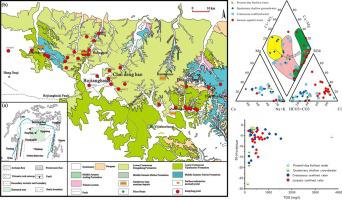当前位置:
X-MOL 学术
›
Ore Geol. Rev.
›
论文详情
Our official English website, www.x-mol.net, welcomes your feedback! (Note: you will need to create a separate account there.)
Hydrogeochemical characteristics of the sandstone-hosted uranium mineralization in northern Ordos Basin, China
Ore Geology Reviews ( IF 3.3 ) Pub Date : 2020-11-01 , DOI: 10.1016/j.oregeorev.2020.103769 Gongxin Chen , Zhanxue Sun , Fengjun Nie , Chenglong Li , Yang Zhen , Zhongkui Zhou
Ore Geology Reviews ( IF 3.3 ) Pub Date : 2020-11-01 , DOI: 10.1016/j.oregeorev.2020.103769 Gongxin Chen , Zhanxue Sun , Fengjun Nie , Chenglong Li , Yang Zhen , Zhongkui Zhou

|
Abstract The northern Ordos Basin is one of the biggest uranium resource production areas in China. However, the hydrogeochemical mechanism for the formation of uranium deposits remains poorly understood, despite that interlayer oxidation, hydrothermal fluid mineralization and gas reduction were proposed. In order to provide a more comprehensive knowledge on their formation mechanism, the investigation was carried out by analyzing hydrogeochemistry and environmental isotopes of waters from river, lakes, shallow private wells, boreholes over the period from 2015 to 2016. The results showed that the analysed samples exhibited a hydrochemical heterogeneity confirmed by a large range of pH, Eh, main cation and anion concentrations, and uranium concentration in surface water, Quaternary shallow groundwater, Cretaceous confined water and Jurassic confined water. The Piper and Durov diagrams highlighted that hydrochemical facies changed with groundwater flow from shallow to deep, with HCO3–Ca•Mg and HCO3–Ca in Quaternary shallow groundwater, HCO3•Cl–Ca•Na in Cretaceous confined water and Cl–Na and HCO3–Na in Jurassic confined water. Aqueous geochemistry indicated that the Jurassic ore-bearing confined waters originated from the Cretaceous confined waters, involving both leaching processes and desulfidation. Nonetheless, the Cretaceous confined waters originated from Quaternary shallow groundwater and mainly have experienced leaching processes. Gibbs plot indicated that, with an accumulation of ions in the groundwater during runoff, calcite and uraninite minerals would be oversaturated and precipitation tended to occur. The variation of TDS along depth indicated desulfurization occurrence in ore-bearing aquifer and a decrease in migrating ability of UO22−, leading to U precipitation. Isotopic results showed that the ore-bearing confined waters were depleted in 18O and D and were located along the global meteoric water line (GMWL). Most ore-bearing confined waters plotted on or near the meteoricwater line, showing their deep-circulating meteoric origin. Uranium species study indicated that dissolved uranium was dominated by UO2(OH)3− and UO2(CO3)34−, which have a high migrating ability. Saturation index of uraninite in all water samples were determined to be below 0, indicating that this uranium deposit was currently not under mineralization. The pH and Eh values of the samples were located in the migration area, suggesting that uranium is in a migration state under current groundwater conditions, only when pH = 5 ~ 8 and Eh
更新日期:2020-11-01



























 京公网安备 11010802027423号
京公网安备 11010802027423号